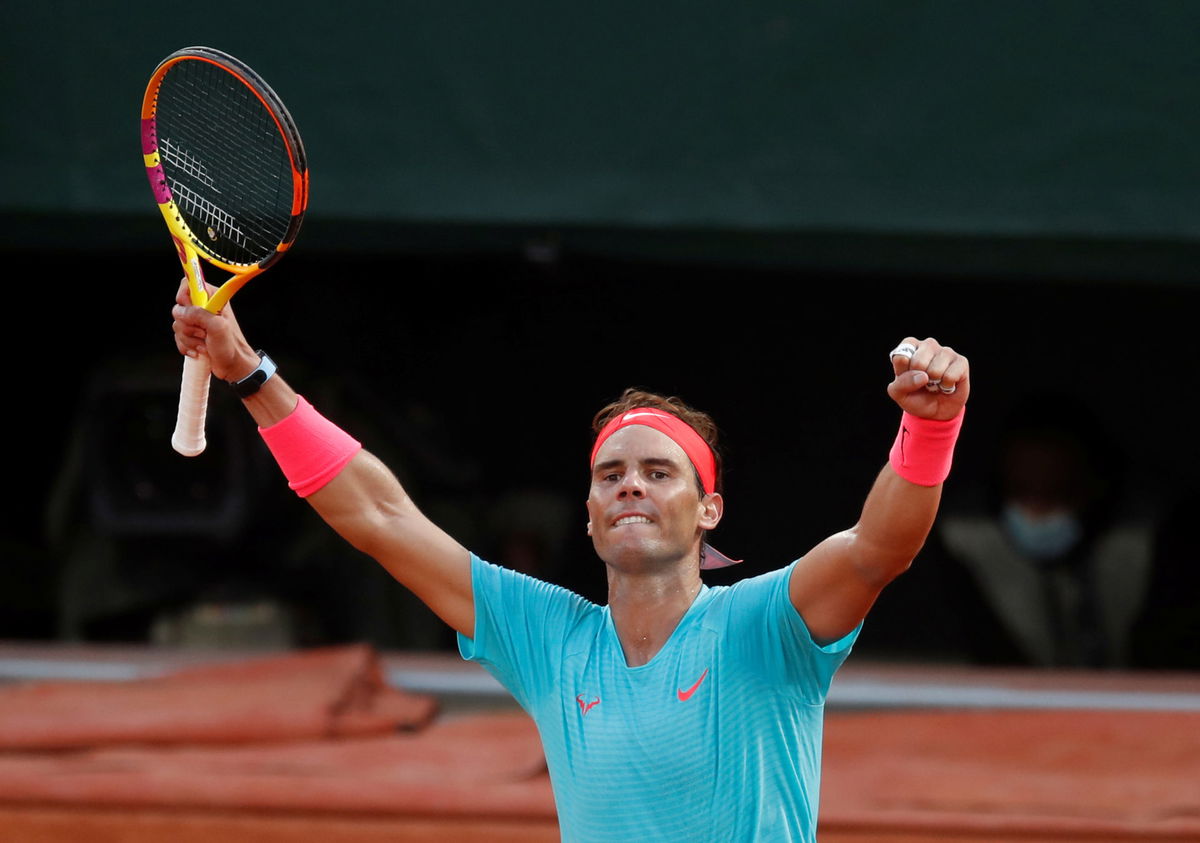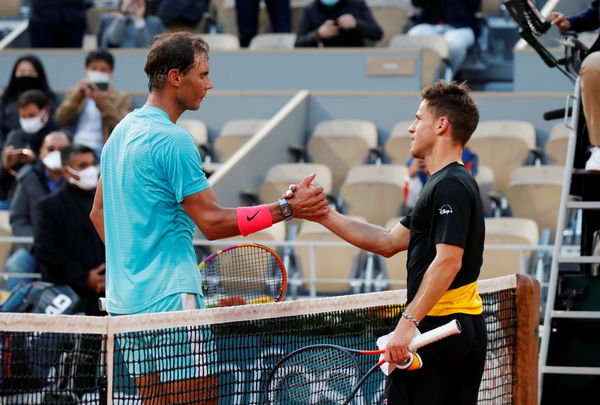
Reuters
Tennis – French Open – Roland Garros, Paris, France – October 9, 2020 Spain’s Rafael Nadal celebrates after winning his semi final match against Argentina’s Diego Schwartzman REUTERS/Gonzalo Fuentes

Reuters
Tennis – French Open – Roland Garros, Paris, France – October 9, 2020 Spain’s Rafael Nadal celebrates after winning his semi final match against Argentina’s Diego Schwartzman REUTERS/Gonzalo Fuentes
Diego Schwartzman has always been a tough opponent to face for Rafael Nadal. Some of their past battles were a lot closer than the scoreline suggested, including the one at the French Open last year.
Watch What’s Trending Now!
However, coming into this year’s match at the French Open 2020, the challenge was even bigger for Nadal as Schwartzman earned his first win over the ‘King of Clay’ just a couple of weeks ago, on clay.
At the same time, the prospect of facing Nadal in a five-setter on Court Philippe Chatrier weighed heavily on the Argentine. And from the outset, in the French Open 2020 semi-final, Nadal made sure a repeat of the Italian Open result was highly improbable.
ADVERTISEMENT
Lucky No.13 awaits…@RafaelNadal notches a straight sets win over Diego Schwartzman 6-3 6-3 7-6(0) to reach his fourth straight, and 13th overall #RolandGarros final. pic.twitter.com/2o55EEWgKA
— Roland-Garros (@rolandgarros) October 9, 2020
Rafael Nadal’s supremacy behind serve
One of the biggest positives for Nadal throughout the French Open has been the momentum he has created. Rafa seemed to find his groove as soon as he stepped onto the courts in Paris and did not let go.
ADVERTISEMENT
He came into the match against Schwartzman, winning 15 sets in a row since his loss to Schwartzman in Rome. A big improvement in Nadal’s game since Rome has been the sheer strength behind the second serve.
That is a massive factor on clay where the first serve percentage tends to drop. Nadal’s 12 titles on the Parisian clay have a lot to do with his consistency behind the serve.
ADVERTISEMENT

Reuters
Tennis – French Open – Roland Garros, Paris, France – October 9, 2020 Spain’s Rafael Nadal in action during his semi final match against Argentina’s Diego Schwartzman REUTERS/Christian Hartmann
In his Rome quarter-final against Schwartzman, Nadal won just 44% of points on his second serve. In their French Open semi-final match, that number shot up to 53%. Nadal has averaged in the high 50s throughout the French Open this year.
Another key improvement in Nadal’s game as compared to Rome were the points won behind his first serve. He won an impressive 69% of points on which he dialed in the first serve in Paris against Schwartzman; that number was below 50% in Rome.
ADVERTISEMENT
How Rafael Nadal perfected his all-round game against Schwartzman
Even the winners to unforced errors ratio showed a massive improvement for the Spaniard. While he made just 21 errors and 30 unforced errors in two sets in the Rome quarter-final, he smashed 38 winners and made just 34 unforced errors over three sets in Paris.

Reuters
Tennis – French Open – Roland Garros, Paris, France – October 9, 2020 Spain’s Rafael Nadal in action during his semi final match against Argentina’s Diego Schwartzman REUTERS/Christian Hartmann
A major factor in making that happen was Nadal’s forehand. He has successfully attacked with the forehand throughout the tournament and forced his opponents into defensive positions on the court. He was unable to do that against Schwartzman in Rome.
ADVERTISEMENT
The average serve as well as shot placement was also a lot more difficult for Schwartzman to conquer.
The ability to perform under pressure
While Nadal was broken 4 times and converted just 2 of 5 breakpoints in the Rome match, that saw a big jump in the Roland Garros match. On Friday, Nadal converted as many as 6 out of 9 break chances. He saved 9 out of 12 break chances that Schwartzman had.
Nadal’s matches are also usually known to be baseline battles. But a very important factor for his success over the years has been his net play. One of the top volleyers on the tour, Nadal won 17 of 24 points at the net against Schwartzman.

Reuters
Tennis – French Open – Roland Garros, Paris, France – October 9, 2020 Spain’s Rafael Nadal shakes hands with Argentina’s Diego Schwartzman after winning the semi final match REUTERS/Charles Platiau
How Rafael Nadal conquered the big points
Nadal’s domination in the French Open semi-final comes down to his ability to dictate the match. That role was assumed by Schwartzman in their Rome match.
Even in the phases, on Friday, where Schwartzman matched up to Nadal’s game, the Spaniard played most of the rallies on his terms.
It is said that playing the big points better separates the great players from the other, and Nadal showed just that throughout the semi-final. He even won the third-set tie-break without dropping a point.
The world number two seems well and truly back in his element in 2020.
ADVERTISEMENT
ADVERTISEMENT
ADVERTISEMENT

